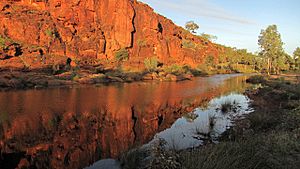Massacre of Running Waters facts for kids
The Running Waters Massacre was a sad event that happened in 1875 in the Northern Territory of Australia. Between 80 and 100 Arrernte (also known as Aranda) men, women, and children were killed. They were from the Southern Arrernte language group of Aboriginal Australians. The attack was carried out by a group of 50 to 60 Matuntara warriors.
The event took place at a spot called Irbmangkara. This is a place with permanent water along the Finke River. It's about 200 kilometers (124 miles) southwest of Alice Springs. The Matuntara people planned this attack as a punishment. They believed the Southern Arrernte had done something very wrong, which they called a "sacrilege." This meant doing something disrespectful to sacred traditions.
We know about what happened at Irbmangkara mostly from the writings of Carl Strehlow. He was a Lutheran anthropologist and linguist who studied the local people and their languages. People living in Hermannsburg today say that this event still affects local politics and relationships in the area.
What Happened at Running Waters?
The massacre began because of a man named Kalejika. He was from a Central Arrernte group. Kalejika visited Irbmangkara and then told some Upper Southern Arrernte men something serious. He claimed that Ltjabakuka, a respected elder and ceremonial chief, and some other elders, had committed a sacrilege.
According to Kalejika, they had given men's blood to boys who were not yet old enough to take part in certain rituals. This blood was meant for special ceremonies. Doing this was considered a very serious offense, and it was usually punished by death.
The Attack
A historian named Geoffrey Blainey wrote about the attack. He said that the group of Aboriginal warriors chose Running Waters because they could easily surprise the Southern Arrernte there. They planned their secret attack for when their enemies were cooking their evening meals.
Three groups of warriors hid in the bushes on nearby mountain slopes. They also hid in the plants along the riverbed. They watched the men and women of Irbmangkara returning to their camp. Then, the armed warriors rushed in quickly. Spears and boomerangs were thrown with great aim. In just a few minutes, Ltjabakuka and his men were killed near their shelters.
After that, the warriors attacked the women and older children. They were killed with spears or clubs. Finally, following a harsh custom, they injured the babies. This left the infants to die on their own. The total number of people killed could have been as high as 80 to 100. One Arrernte woman survived by pretending to be dead. She then escaped north to warn others.
A Witness's Story
A man named Moses Tjalkabota was a small boy at the time. He was deeply affected by the massacre. Two of his friends and their mother were killed in the attack. He also saw the large clouds of smoke rising from the funeral pyres the next day. This is where the bodies were burned. Much later, his memories of the killings were written down and translated into English. His story matches many of the details about how harsh the raid was.
See also
- List of massacres of Indigenous Australians


